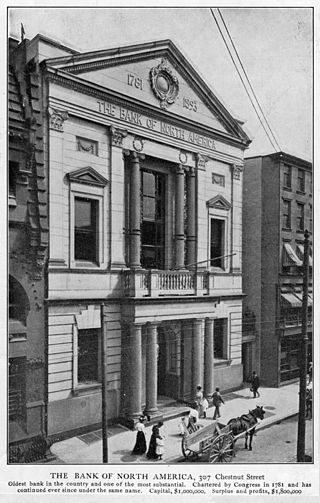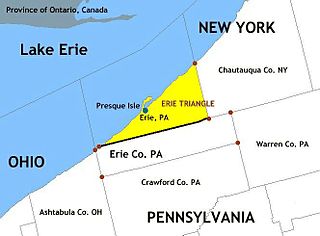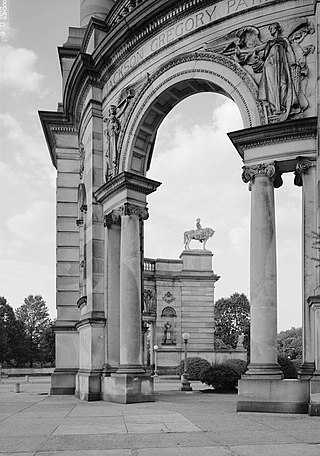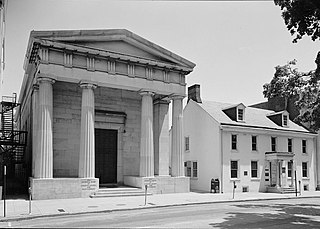
The Second Bank of the United States was the second federally authorized Hamiltonian national bank in the United States. Located in Philadelphia, Pennsylvania, the bank was chartered from February 1816 to January 1836. The bank's formal name, according to section 9 of its charter as passed by Congress, was "The President, Directors, and Company, of the Bank of the United States". While other banks in the US were chartered by and only allowed to have branches in a single state, it was authorized to have branches in multiple states and lend money to the US government.

The Bank of North America was the first chartered bank in the United States, and served as the country's first de facto central bank. It was chartered by the Congress of the Confederation on May 26, 1781, and opened in Philadelphia on January 7, 1782.

The National Banking Acts of 1863 and 1864 were two United States federal banking acts that established a system of national banks chartered at the federal level, and created the United States National Banking System. They encouraged development of a national currency backed by bank holdings of U.S. Treasury securities and established the Office of the Comptroller of the Currency as part of the United States Department of the Treasury. The Act shaped today's national banking system and its support of a uniform U.S. banking policy.

Jay Cooke was an American financier who helped finance the Union war effort during the American Civil War and the postwar development of railroads in the northwestern United States. He is generally acknowledged as the first major investment banker in the United States and creator of the first wire house firm.

The Wells Fargo Center is a multi-purpose indoor arena located in Philadelphia. It serves as the home of the Philadelphia Flyers of the National Hockey League (NHL), the Philadelphia 76ers of the National Basketball Association (NBA), and the Philadelphia Wings of the National Lacrosse League (NLL). The arena lies at the southwest corner of the South Philadelphia Sports Complex, which includes Lincoln Financial Field, Citizens Bank Park, and Xfinity Live!.

The Erie Triangle is a roughly 300-square-mile (780-square-kilometre) tract of American land that was the subject of several competing colonial-era claims. It was eventually acquired by the U.S. federal government and sold to Pennsylvania so that the state would have access to a freshwater port on Lake Erie. The Erie Triangle land makes up a large portion of present-day Erie County, Pennsylvania.
CoreStates Financial Corporation, previously known as Philadelphia National Bank (PNB), was an American bank holding company in the Philadelphia, Pennsylvania, metropolitan area.

Desert Financial Arena is a 14,198-seat multi-purpose arena located at 600 E Veterans Way in Tempe, Arizona, United States, in the Phoenix metropolitan area. It sits immediately east of Mountain America Stadium on the northern edge of the Tempe campus of Arizona State University (ASU).

The El Vernona Hotel–John Ringling Hotel was a famous hotel located at 111 North Tamiami Trail in Sarasota, Florida, United States.

Dacotah Field is an outdoor stadium in the north central United States, on the campus of North Dakota State University (NDSU) in Fargo, North Dakota. It is the former home of the North Dakota State Bison football team, and the current home of the North Dakota State Bison women's soccer team. The field runs east-west at an approximate elevation of 900 feet (275 m) above sea level.

The Clay County Savings Association in Liberty, Missouri, was robbed on February 13, 1866, making it one of the earliest documented daylight bank robberies. The robbers escaped with at least $60,000 and killed a bystander outside. The robbery is believed to have been conducted by a group of former Confederate guerrillas, possibly led by Jesse James or Archie Clement, which became known as the James–Younger Gang.

Thackeray Hall is an academic building of the University of Pittsburgh and a contributing property to the Schenley Farms National Historic District at 139 University Place on the campus of the University of Pittsburgh in Pittsburgh, Pennsylvania, United States.

The Centennial National Bank is a historic building in Philadelphia, Pennsylvania. Designed by noted Philadelphia architect Frank Furness and significant in his artistic development, it was built in 1876 as the headquarters of the eponymous bank that would be the fiscal agent of the Centennial Exposition. The building housed a branch of the First Pennsylvania Bank from 1956 until Drexel University purchased it c. 1976. Drexel renovated it between 2000-2002 and now uses it as an alumni center. The Centennial National Bank, described as "one of the best pieces of architecture in West Philadelphia," was placed on the National Register of Historic Places in 1971.
The Bank of Pennsylvania or the Pennsylvania Bank can refer to two institutions: one that existed during the American Revolutionary War, and another chartered by the state in 1793.

Smith Memorial Arch is an American Civil War monument at South Concourse and Lansdowne Drive in Philadelphia, Pennsylvania. Built on the former grounds of the 1876 Centennial Exposition, it serves as a gateway to West Fairmount Park. The Memorial consists of two colossal columns supported by curving, neo-Baroque arches, and adorned with 13 individual portrait sculptures ; two eagles standing on globes; and architectural reliefs of eight allegorical figures.
Clarence Howard Clark Jr. was a financier in Philadelphia, Pennsylvania.

Bank of Chester County is a historic two-story bank building located in West Chester, Chester County, Pennsylvania, the first bank to be chartered in the county. Following the failure to renew the charter of the Bank of the United States in 1811, states received responsibility over the banking systems within their jurisdiction. Although an initial proposal was rejected by the state legislature in 1813, a 41-bank proposal was passed the following year. An early bank building was utilized in West Chester beginning in 1814 at the Record Office, though the bank was relocated in 1818 to a building across the street, present-day 13 High Street. Following a proposal for a new site in 1835, a bank, to be built at 17 High Street, designed by architect Thomas Ustick Walter (1804–1887). It was built in 1836 in the Greek Revival style at the cost of $33,000, and features a portico with four Doric order columns; the bank was subsequently altered in 1874, 1905, and 1928. The previous building has since been rented to numerous individuals, although it still houses outdated equipment no longer used by the bank. The current building is occupied by Wells Fargo.
The National Bank of Delaware was the first bank chartered in the U.S. state of Delaware. Based in Wilmington, the bank operated independently from 1795 to 1929, when it was merged into the Security Trust Company, also of Wilmington.

The Erie County Savings Bank building was a 10-story Romanesque Revival, office and bank branch building that was located at present-day 9 Church Street in downtown Buffalo, New York.

Robinson Gymnasium was the first true gymnasium for the University of Kansas (KU) in Lawrence, Kansas and home to the Kansas Jayhawks men's basketball program from 1907 to 1927. It was designed by James Naismith at a cost of $100,000. The creation of the modern facilities were led by Naismith and Chancellor Frank Strong. Naismith wanted the gymnasium not just for basketball but also for his other physical education classes and sports activities. The gymnasium was named after Charles L. Robinson, who was the first Governor of Kansas, and his wife Sara Tappan Doolittle Robinson, both as thanks for their service and to make amends for what Sara perceived to be excessive pressure on her nephew to sell 51 acres (21 ha) of land to KU at a below-market price. Construction began in 1905 and was completed in May 1907.


















